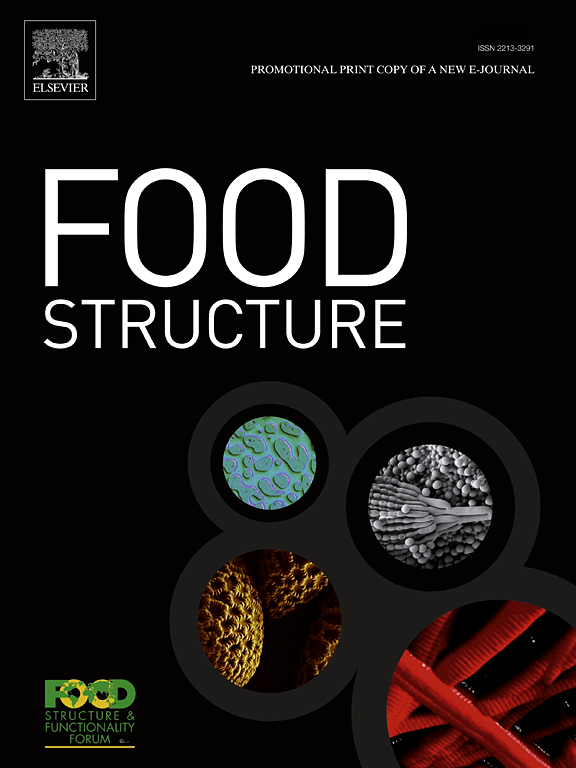Impact of soy protein concentrate preparation method on structure formation during high moisture extrusion
IF 5.9
3区 农林科学
Q1 FOOD SCIENCE & TECHNOLOGY
引用次数: 0
Abstract
The impact of soy protein concentrate (SPC) preparation method on its physicochemical properties and structure formation during processing with high moisture extrusion remains largely unexplored. In this study, SPCs were prepared by washing steps using acidic solutions at pH 4.5 or 5.5 (pH4.5- or pH5.5-SPCs), or using 50 % or 70 % aqueous ethanol solutions (E50- or E70-SPCs). The SPC protein dispersibilities, water-holding capacities, and rheological properties were analyzed at extrusion-relevant dry matter-to-waterlevels and related to structure and texture of extrudates made from these SPCs. pH4.5-SPC had the highest water-holding capacity, and E70-SPC the lowest. Rheological experiments showed higher complex viscosity of pH-SPCs heated to 140 °C and cooled to 60 °C compared to E-SPCs. Extrusion trials were conducted with a Thermo Fisher Process 11 extruder. pH-SPC extrudates exhibited anisotropic fibrous macrostructure and V-shaped protein-rich lamellae, whereas E70-SPC extrudates lacked distinct fibrous structure. X-ray tomography revealed thicker protein-rich lamellae in E70-SPC extrudates, indicating less pronounced syneresis during extrusion, which likely relates to its softer texture than the other extrudates. Correlation analysis suggested that rheological properties determined at extrusion-like temperatures can be indicative of extrudate texture. In conclusion, the used protein preparation protocol significantly impacted the physicochemical and rheological properties of SPCs, which then affected the structure and texture of extrudates made from these SPCs.
大豆浓缩蛋白制备方法对高湿挤压过程中结构形成的影响
在高水分挤压加工过程中,大豆浓缩蛋白制备方法对其理化性质和结构形成的影响尚未得到充分研究。在本研究中,通过使用pH为4.5或5.5的酸性溶液(pH4.5-或pH5.5-SPCs)或使用50% %或70% %的乙醇水溶液(E50-或E70-SPCs)的洗涤步骤制备SPCs。SPC蛋白的分散性、保水能力和流变性能在与挤出相关的干物质-水水平下进行了分析,并与SPC制成的挤出物的结构和质地相关。pH4.5-SPC保水能力最强,E70-SPC保水能力最低。流变学实验表明,pH-SPCs在加热至140°C和冷却至60°C时的复合粘度高于E-SPCs。用赛默飞世尔工艺11挤出机进行了挤出试验。pH-SPC挤出物具有各向异性的纤维宏观结构和富含蛋白质的v形片层,而E70-SPC挤出物缺乏明显的纤维结构。x射线断层扫描显示,E70-SPC挤出物中富含蛋白质的片层较厚,表明挤出过程中的协同作用不太明显,这可能与它比其他挤出物更柔软的质地有关。相关分析表明,在类似挤出的温度下确定的流变特性可以指示挤出物的织构。综上所述,所使用的蛋白质制备方案显著影响了SPCs的物理化学和流变性能,进而影响了SPCs制成的挤出物的结构和质地。
本文章由计算机程序翻译,如有差异,请以英文原文为准。
求助全文
约1分钟内获得全文
求助全文
来源期刊

Food Structure-Netherlands
Chemical Engineering-Bioengineering
CiteScore
7.20
自引率
0.00%
发文量
48
期刊介绍:
Food Structure is the premier international forum devoted to the publication of high-quality original research on food structure. The focus of this journal is on food structure in the context of its relationship with molecular composition, processing and macroscopic properties (e.g., shelf stability, sensory properties, etc.). Manuscripts that only report qualitative findings and micrographs and that lack sound hypothesis-driven, quantitative structure-function research are not accepted. Significance of the research findings for the food science community and/or industry must also be highlighted.
 求助内容:
求助内容: 应助结果提醒方式:
应助结果提醒方式:


